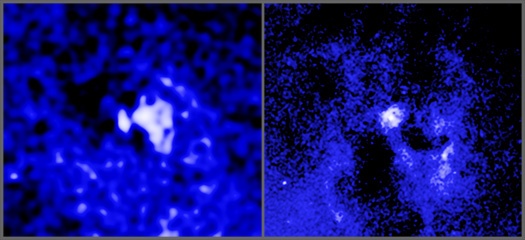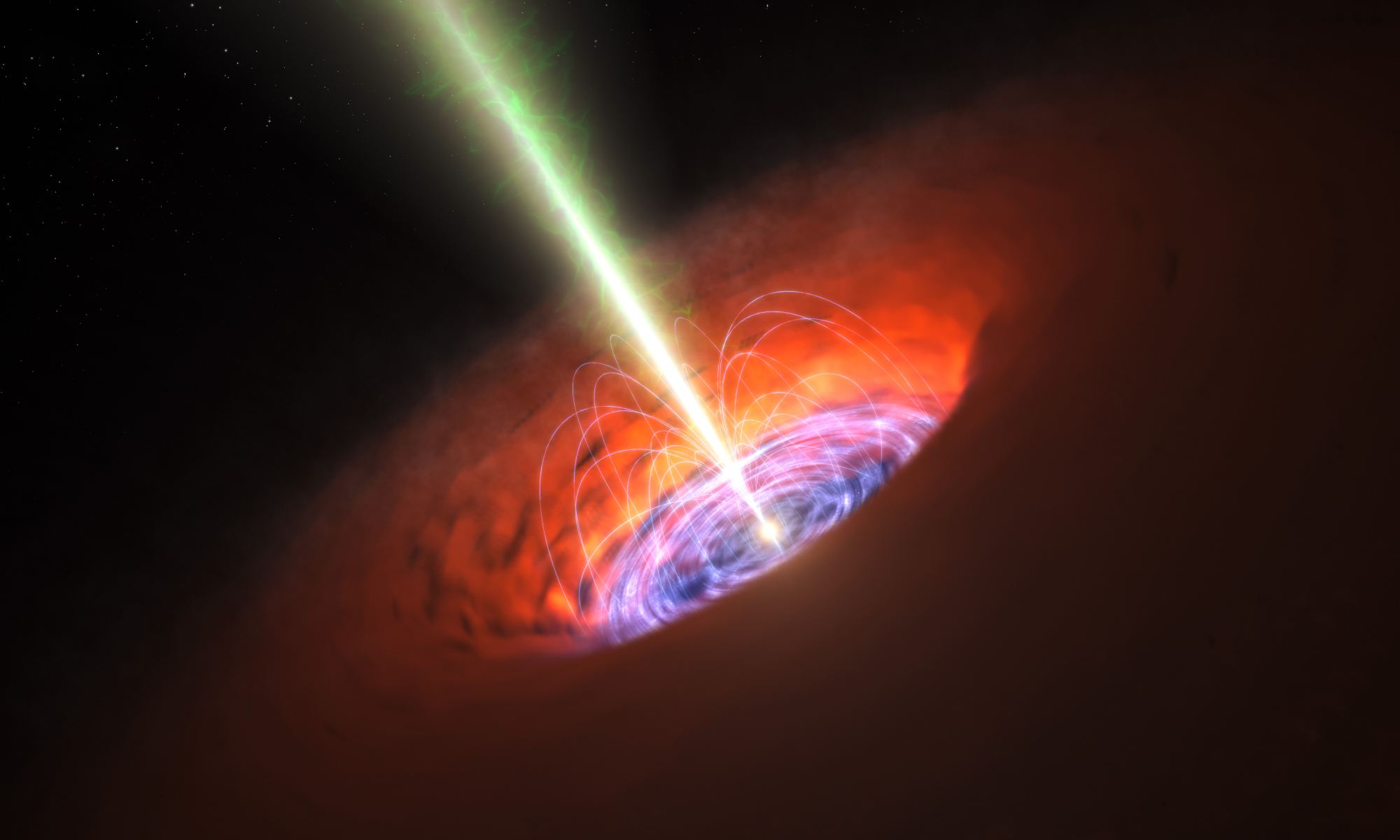Most galaxies are thought to play host to black holes. At the center of Centaurus A, a galaxy 12 million light years away, a jet is being fired out into space. Images that have been captured by NASA’s Chandra X-ray observatory show that the high energy particles have struck a nearby object creating a shockwave. The target is thought to be a giant star, maybe even a binary system, where the collision and turbulence has increased density in the region.
Continue reading “Zap! A Black Hole Scores a Direct Hit With its Jet”Astronomers Find the Longest Black Hole Jets Ever Seen
Black holes often appear in science fiction movies, largely because elements of their existence are still a mystery. They have fascinating impacts on the surrounding region of space too with distortions in space and time high on the list. A team of astronomers have found a supermassive black hole with twin jets blasting out an incredible 23 million light years, the longest yet. To put this into context, if you lined up 140 Milky Way galaxies side by side, then that’s the length of the jet!
Continue reading “Astronomers Find the Longest Black Hole Jets Ever Seen”Hot Gas is Being Vented Away from the Center of the Milky Way

Studying gas in the Universe is no easy task. We often look to ‘non-visible’ wavelengths of the electromagnetic spectrum such as X-rays. The Chandra X-Ray observatory has been observing a vent of hot gas blowing away from the centre of the Milky Way. Located about 26,000 light years away, the jet extends for hundreds of light years and is perpendicular to the disk of the Galaxy. It is now thought the gas has been forced away from the centre of the Milky Way because of a collision with cooler gas lying in its path and creating shockwaves.
Continue reading “Hot Gas is Being Vented Away from the Center of the Milky Way”Black Holes are Firing Beams of Particles, Changing Targets Over Time
Black holes seem to provide endless fascination to astronomers. This is at least partly due to the extreme physics that takes place in and around them, but sometimes, it might harken back to cultural touchpoints that made them interested in astronomy in the first place. That seems to be the case for the authors of a new paper on the movement of jets coming out of black holes. Dubbing them “Death Star” black holes, researchers used data from the Very Long Baseline Array (VLBA) and the Chandra X-ray Observatory to look at where these black holes fired jets of superheated particles. And over time the found they did something the fiction Death Star could also do – move.
Continue reading “Black Holes are Firing Beams of Particles, Changing Targets Over Time”It's Confirmed. M87's Black Hole is Actually Spinning
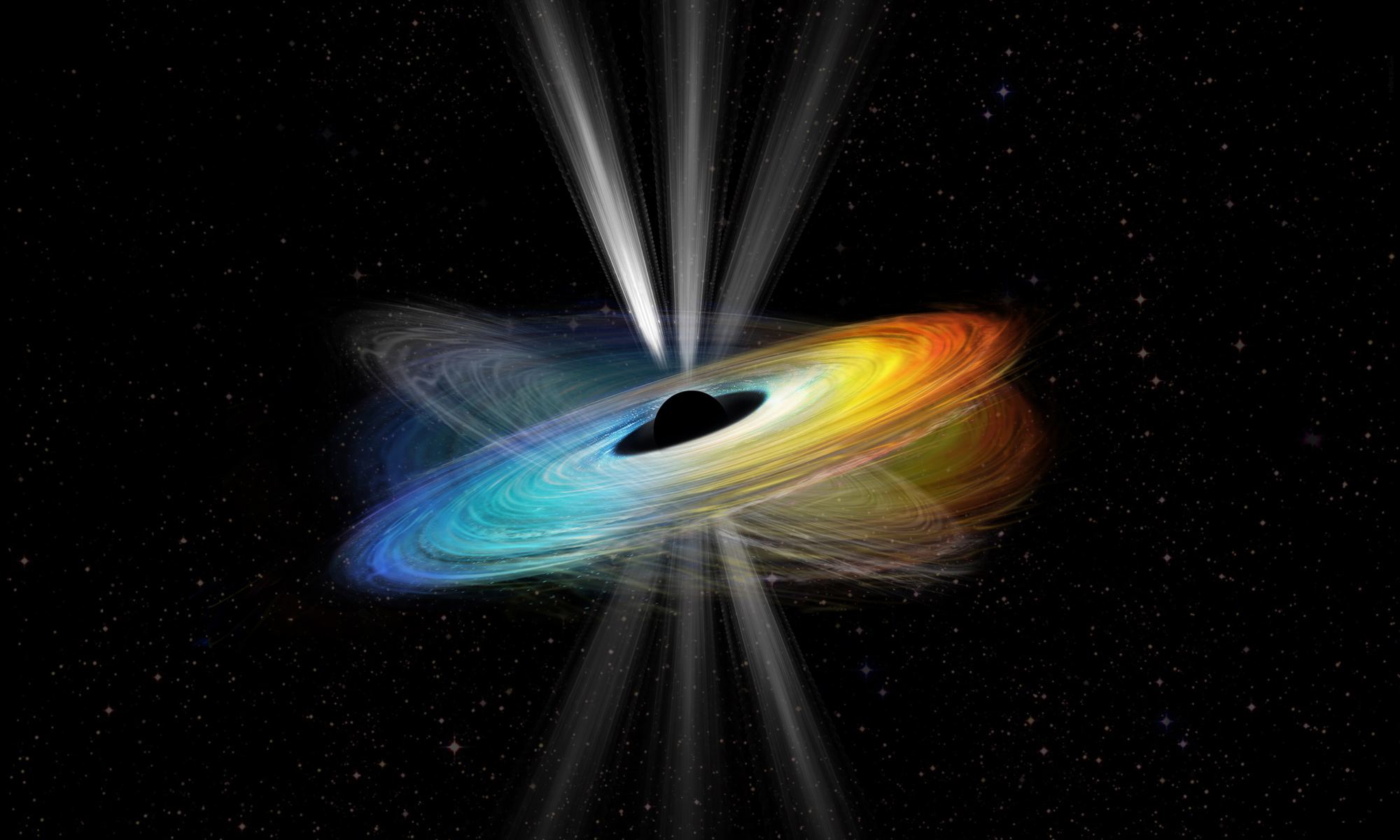
Fifty-five million light-years away, in the galaxy known as M87, lies a supermassive black hole. It is a powerfully active black hole with a mass of 6.5 billion Suns, and in 2019 it was the first black hole to be imaged directly. The radio image captured by the Event Horizon Telescope (EHT) shows a halo of ambient light warped by the black hole’s gravity and directed our way. On one side of the halo, the light is brighter, which according to general relativity is due to the rotation or spin of the black hole. It was the first direct confirmation that the black hole rotates. A new study published in Nature has given us more rotational evidence.
Continue reading “It's Confirmed. M87's Black Hole is Actually Spinning”Advanced Life Should Have Already Peaked Billions of Years Ago

Did humanity miss the party? Are SETI, the Drake Equation, and the Fermi Paradox all just artifacts of our ignorance about Advanced Life in the Universe? And if we are wrong, how would we know?
A new study focusing on black holes and their powerful effect on star formation suggests that we, as advanced life, might be relics from a bygone age in the Universe.
Continue reading “Advanced Life Should Have Already Peaked Billions of Years Ago”A Star Came too Close to a Black Hole. It Didn’t End Well
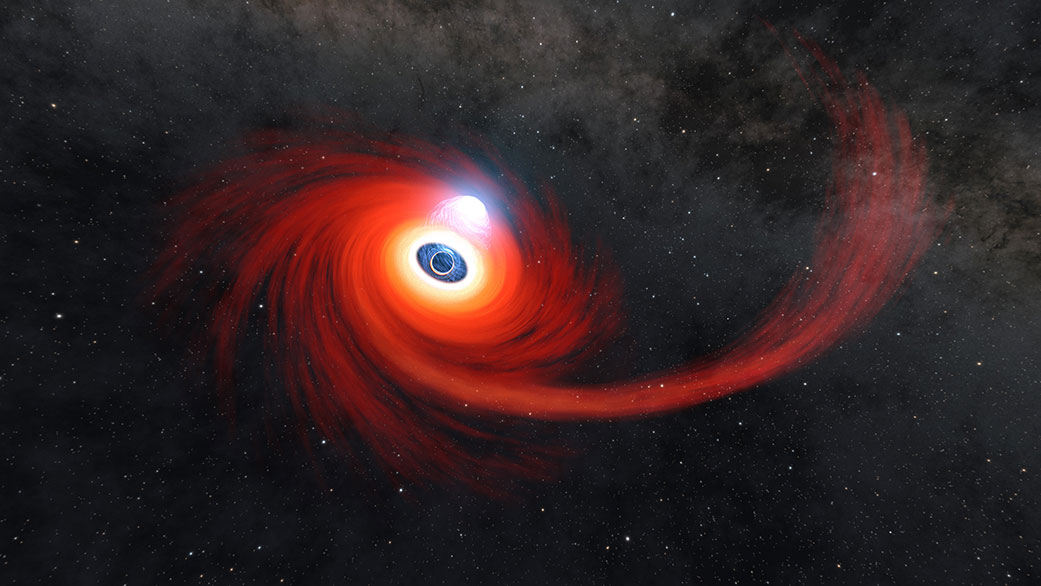
Black holes are confounding objects that stretch physics to its limits. The most massive ones lurk in the centers of large galaxies like ours. They dominate the galactic center, and when a star gets too close, the black hole’s powerful gravitational force tears the star apart as they feed on it. Not even the most massive stars can resist.
But supermassive black holes (SMBHs) didn’t start out that massive. They attained their gargantuan mass by accreting material over vast spans of time and by merging with other black holes.
There are large voids in our understanding of how SMBHs grow and evolve, and one way astrophysicists fill those voids is by watching black holes as they consume stars.
Continue reading “A Star Came too Close to a Black Hole. It Didn’t End Well”A Black Hole has been Burping for 100 Million Years
Black holes are gluttonous behemoths that lurk in the center of galaxies. Almost everybody knows that nothing can escape them, not even light. So when anything made of simple matter gets too close, whether a planet, a star or a gas cloud, it’s doomed.
But the black hole doesn’t eat it at once. It plays with its food like a fussy kid. Sometimes, it spews out light.
When the black hole is not only at the center of a galaxy but the center of a cluster of galaxies, these burps and jets carve massive cavities out of the hot gas at the center of the cluster called radio bubbles.
Continue reading “A Black Hole has been Burping for 100 Million Years”M87’s Black Hole is Firing Out Jets that Travel 99% the Speed of Light
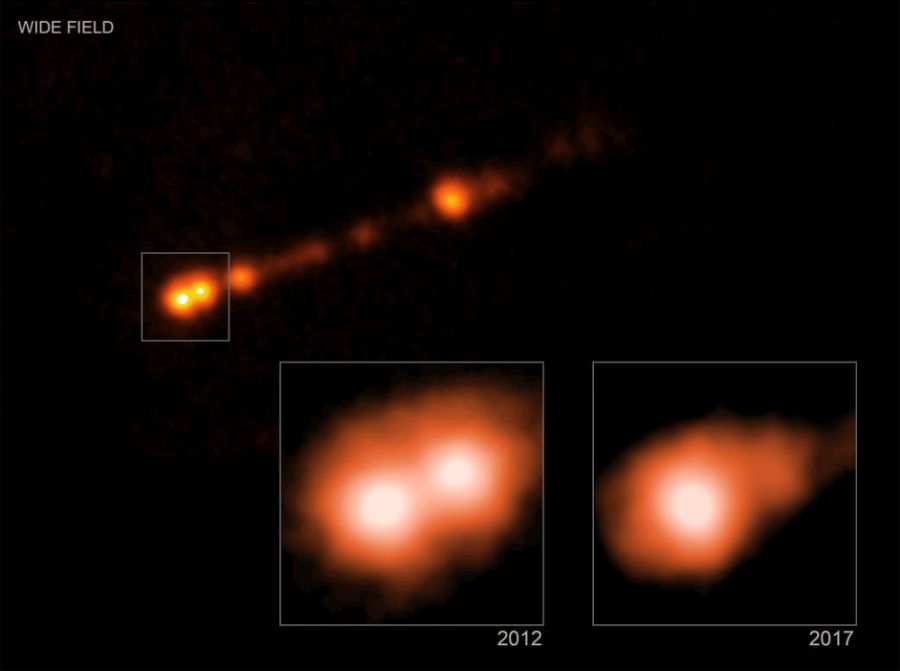
Can black holes be famous? If they can, then the one at the heart of the M87 galaxy qualifies. And this famous black hole is emitting jets of material that travel at near the speed of light.
Continue reading “M87’s Black Hole is Firing Out Jets that Travel 99% the Speed of Light”What are Active Galactic Nuclei?

In the 1970s, astronomers became aware of a compact radio source at the center of the Milky Way Galaxy – which they named Sagittarius A. After many decades of observation and mounting evidence, it was theorized that the source of these radio emissions was in fact a supermassive black hole (SMBH). Since that time, astronomers have come to theorize that SMBHs at the heart of every large galaxy in the Universe.
Most of the time, these black holes are quiet and invisible, thus being impossible to observe directly. But during the times when material is falling into their massive maws, they blaze with radiation, putting out more light than the rest of the galaxy combined. These bright centers are what is known as Active Galactic Nuclei, and are the strongest proof for the existence of SMBHs.
Description:
It should be noted that the enormous bursts in luminosity observed from Active Galactic Nuclei (AGNs) are not coming from the supermassive black holes themselves. For some time, scientists have understood that nothing, not even light, can escape the Event Horizon of a black hole.
Instead, the massive burst of radiations – which includes emissions in the radio, microwave, infrared, optical, ultra-violet (UV), X-ray and gamma ray wavebands – are coming from cold matter (gas and dust) that surround the black holes. These form accretion disks that orbit the supermassive black holes, and gradually feeding them matter.
The incredible force of gravity in this region compresses the disk’s material until it reaches millions of degrees kelvin. This generates bright radiation, producing electromagnetic energy that peaks in the optical-UV waveband. A corona of hot material forms above the accretion disc as well, and can scatter photons up to X-ray energies.
A large fraction of the AGN’s radiation may be obscured by interstellar gas and dust close to the accretion disc, but this will likely be re-radiated at the infrared waveband. As such, most (if not all) of the electromagnetic spectrum is produced through the interaction of cold matter with SMBHs.
The interaction between the supermassive black hole’s rotating magnetic field and the accretion disk also creates powerful magnetic jets that fire material above and below the black hole at relativistic speeds (i.e. a significant fraction of the speed of light). These jets can extend for hundreds of thousands of light-years, and are a second potential source of observed radiation.
Types of AGN:
Typically, scientists divide AGN into two categories, which are referred to as “radio-quiet” and “radio-loud” nuclei. The radio-loud category corresponds to AGNs that have radio emissions produced by both the accretion disk and the jets. Radio-quiet AGNs are simpler, in that any jet or jet-related emission are negligible.
Carl Seyfert discovered the first class of AGN in 1943, which is why they now bear his name. “Seyfert galaxies” are a type of radio-quiet AGN that are known for their emission lines, and are subdivided into two categories based on them. Type 1 Seyfert galaxies have both narrow and broadened optical emissions lines, which imply the existence of clouds of high density gas, as well as gas velocities of between 1000 – 5000 km/s near the nucleus.
Type 2 Seyferts, in contrast, have narrow emissions lines only. These narrow lines are caused by low density gas clouds that are at greater distances from the nucleus, and gas velocities of about 500 to 1000 km/s. As well as Seyferts, other sub classes of radio-quiet galaxies include radio-quiet quasars and LINERs.
Low Ionisation Nuclear Emission-line Region galaxies (LINERs) are very similar to Seyfert 2 galaxies, except for their low ionization lines (as the name suggests), which are quite strong. They are the lowest-luminosity AGN in existence, and it is often wondered if they are in fact powered by accretion on to a supermassive black hole.

Radio-loud galaxies can also be subdivded into categories like radio galaxies, quasars, and blazars. As the name suggests, radio galaxies are elliptical galaxies that are strong emitters of radiowaves. Quasars are the most luminous type of AGN, which have spectra similar to Seyferts.
However, they are different in that their stellar absorption features are weak or absent (meaning they are likely less dense in terms of gas) and the narrow emission lines are weaker than the broad lines seen in Seyferts. Blazars are a highly variable class of AGN that are radio sources, but do not display emission lines in their spectra.
Detection:
Historically speaking, a number of features have been observed within the centers of galaxies that have allowed for them to be identified as AGNs. For instance, whenever the accretion disk can be seen directly, nuclear-optical emissions can be seen. Whenever the accretion disk is obscured by gas and dust close to the nucleus, an AGN can be detected by its infra-red emissions.
Then there are the broad and narrow optical emission lines that are associated with different types of AGN. In the former case, they are produced whenever cold material is close to the black hole, and are the result of the emitting material revolving around the black hole with high speeds (causing a range of Doppler shifts of the emitted photons). In the former case, more distant cold material is the culprit, resulting in narrower emission lines.
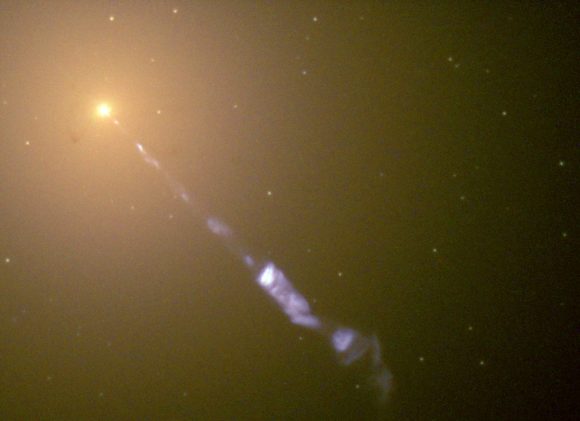
Next up, there are radio continuum and x-ray continuum emissions. Whereas radio emissions are always the result of the jet, x-ray emissions can arise from either the jet or the hot corona, where electromagnetic radiation is scattered. Last, there are x-ray line emissions, which occur when x-ray emissions illuminate the cold heavy material that lies between it and the nucleus.
These signs, alone or in combination, have led astronomers to make numerous detections at the center of galaxies, as well as to discern the different types of active nuclei out there.
The Milky Way Galaxy:
In the case of the Milky Way, ongoing observation has revealed that the amount of material accreted onto Sagitarrius A is consistent with an inactive galactic nucleus. It has been theorized that it had an active nucleus in the past, but has since transitioned into a radio-quiet phase. However, it has also been theorized that it might become active again in a few million (or billion) years.
When the Andromeda Galaxy merges with our own in a few billion years, the supermassive black hole that is at its center will merge with our own, producing a much more massive and powerful one. At this point, the nucleus of the resulting galaxy – the Milkdromeda (Andrilky) Galaxy, perhaps? – will certainly have enough material for it to be active.
The discovery of active galactic nuclei has allowed astronomers to group together several different classes of galaxies. It’s also allowed astronomers to understand how a galaxy’s size can be discerned by the behavior at its core. And last, it has also helped astronomers to understand which galaxies have undergone mergers in the past, and what could be coming for our own someday.
We have written many articles about galaxies for Universe Today. Here’s What Fuels the Engine of a Supermassive Black Hole?, Could the Milky Way Become a Black Hole?, What is a Supermassive Black Hole?, Turning on a Supermassive Black Hole, What Happens when Supermassive Black Holes Collide?.
For more information, check out Hubblesite’s News Releases on Galaxies, and here’s NASA’s Science Page on Galaxies.
Astronomy Cast also has episodes about galactic nuclei and supermassive black holes. Here’s Episode 97: Galaxies and Episode 213: Supermassive Black Holes.
Source:



